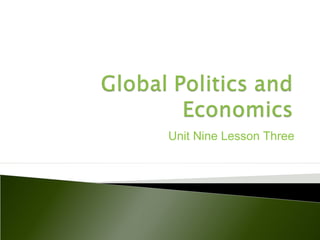
Unit 9 lesson 3 global politics and economics
- 1. Unit Nine Lesson Three
- 2. Objectives • Analyze how the United States responded to changes in the global economy. • Assess the foreign policy goals and actions of the Clinton administration. • Describe U.S. relations with various Middle Eastern countries and groups.
- 3. Terms and People • EU – the European Union, an economic and political union of European nations established in 1993 • NAFTA – the North American Free Trade Agreement, signed in 1993, which called for the removal of trade restrictions between Canada, Mexico, and the United States • WTO – the World Trade Organization, which replaced GATT in 1995, to encourage the expansion of world trade • ethnic cleansing − a systematic effort to purge an area or society of an ethnic group through murder or deportation • al Qaeda − a terrorist group established by Osama bin Laden to rid Muslim countries of Western influence
- 4. What role did the United States take on in global politics and economics following the Cold War? After the Cold War ended, the United States carved out a new role in a world of globalization and increasing regional conflict. No longer defined by an opposition to communism, America faced this new era under the leadership of President Clinton.
- 5. “We believe that the central challenge we face today is to ensure that globalization becomes a positive force for all the world’s people. For a while globalization offers great opportunities, at present its benefits are very unevenly shared, while its costs are unevenly distributed… Only through broad and sustained efforts to create a shared future, based upon our common humanity in all its diversity, can globalization be made fully inclusive and equitable.” Millennium Dedication, September 8, 2000
- 6. A world economic leader, the U.S. supported free trade blocs and promoted globalization. Under Clinton’s watch the U.S. agreed to NAFTA, the North American response to Europe’s EU, in 1994. But many groups opposed NAFTA, saying it would take jobs away from the U.S. and hurt the environment.
- 7. Trade between the U.S., Canada, and Mexico increased between 1990 and 2000.
- 8. Clinton signed 270 free trade agreements, including GATT and the accords of the World Trade Organization (WTO). Although critics continued to raise concerns over these agreements, most people agree that economic globalization has had positive effects.
- 9. With the Cold War over, the U.S. had to redefine its role in the world. It took a primary role in financing and managing the World Bank, which helps developing nations with issues such as health care, human rights, and poverty. The U.S. believes that developing countries with stable economies are vital to its own security.
- 10. U.S. Military Intervention in the 1990s Many Americans favored economic support for foreign countries. Just as 1992 – Somalia many feared lending military support to embattled nations. 1994 – Haiti But Clinton felt several conflicts demanded U.S intervention.
- 11. In the Balkans, the fall of communism brought about the destabilization of Yugoslavia. Long-simmering ethnic and religious tensions came to a boil in the region. A brutal civil war erupted between Serbs, Bosnians, and Croats. In 1995, NATO bombed Serbian strongholds in order to end their brutal practice of ethnic cleansing in Bosnia.
- 12. Conflict in the Middle East increased in the 1990s. Fighting between the Israelis and Palestinians became more violent, threatening to destabilize the entire region. In 2000, Clinton brought Palestinian leader Yasir Arafat and Israeli leader Ehud Barak to Camp David to broker a peace agreement between them. It was not successful.
- 13. The U.S. itself became a target of Middle Eastern extremists. A terrorist group called al Qaeda exploded a bomb in the World Trade Center in New York City in 1993. The group also set off bombs killing more 225 people at American embassies in Kenya and Tanzania. In 2000, they attacked the USS Cole, a warship anchored off Yemen, killing 17 American sailors. American leaders learned that fighting terrorism would be extremely difficult.